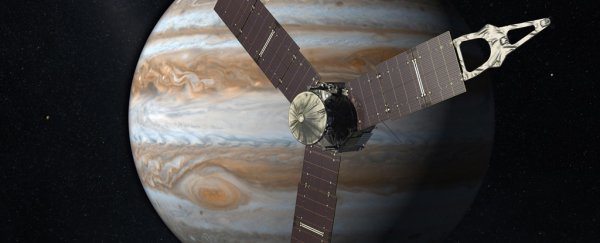On the home stretch to Jupiter, NASA's Juno probe has made history, becoming the most distant solar-powered spacecraft ever launched by humankind.
Juno broke the record this week at 19:00 UTC on Wednesday, January 13, hitting a whopping 793 million kilometres (493 million miles) from the Sun – not too shabby for a vessel that relies on solar rays to keep the lights on.
Juno pipped the European Space Agency's Rosetta spacecraft, the orbit of which hit a high point of 792 million kilometres (492 million miles) in October 2012 as it homed in on the comet 67P/Churyumov-Gerasimenko.
Juno's accomplishment is all the more impressive when you consider that the farther it gets from the Sun, the weaker the solar rays that power the craft become. And Juno's power supply will keep getting fainter as the craft approaches its research destination, which it will arrive at on July 4 this year.
"Jupiter is five times farther from the Sun than Earth, and the sunlight that reaches that far out packs 25 times less punch," said Rick Nybakken, Juno's project manager at NASA's Jet Propulsion Laboratory. "While our massive solar arrays will be generating only 500 watts when we are at Jupiter, Juno is very efficiently designed, and it will be more than enough to get the job done."
That efficient design is apparent in the craft's distinctive shape (see the image above), with its three 9-metre-long (30 foot) solar arrays packed to the brim with some 18,698 individual solar cells. At Earth's distance from the Sun, that volume of solar cells, which is spread out over approximately 72 square metres (775 square foot) of panelling, would give Juno the capability to generate approximately 14 kilowatts of electricity.
At its peak distance, Juno will get 832 million kilometres (517 million miles) from the Sun, and will orbit Jupiter 33 times. The purpose of the mission is to probe the planet's cloud cover and study its aurorae to find out what we can about Jupiter's origins, structure, atmosphere, and magnetosphere.
"[T]he best is yet to come," said Scott Bolton, Juno principal investigator at the Southwest Research Institute in San Antonio. "We are achieving these records and venturing so far out for a reason – to better understand the biggest world in our Solar System and thereby better understand where we came from."
And the most exciting part is we're only half a year away from Juno reaching its target, the culmination of an epic mission NASA has been working towards since the craft's launch in 2011.
"Juno is all about pushing the edge of technology to help us learn about our origins," said Bolton. "We use every known technique to see through Jupiter's clouds and reveal the secrets Jupiter holds of our Solar System's early history. It just seems right that the Sun is helping us learn about the origin of Jupiter and the other planets that orbit it."
Check out the video below to get a sense of just how far-flung Juno's voyage really is:
